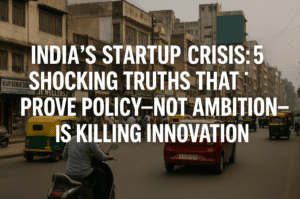India’s Startup Crisis: 5 Shocking Truths That Prove Policy—Not Ambition—is Killing Innovation
India’s startup scene reflects the country’s broader economic and policy landscape rather than a lack of entrepreneurial ambition. Commerce Minister Piyush Goyal’s criticism overlooks the systemic issues that shape startup choices—such as restrictive labor laws, tax uncertainty, limited access to credit, and weak infrastructure. Unlike China’s state-supported deep-tech ecosystem, India’s economy is driven by consumer demand, especially from the price-sensitive “India-2” segment.
This naturally leads to the rise of delivery and service-oriented startups over industrial or tech-heavy ventures. Despite this, innovation is emerging in niches like space-tech and geospatial analytics. To unlock deeper innovation, India must simplify regulations, invest in R&D, improve funding mechanisms, and build stronger links between academia and industry. The focus should shift from blaming startups to fixing the policy framework that restricts their evolution. Only then can India truly build a diversified and resilient innovation economy.

India’s Startup Crisis: 5 Shocking Truths That Prove Policy—Not Ambition—is Killing Innovation
When India’s Commerce Minister Piyush Goyal recently criticized homegrown startups for prioritizing food delivery and consumer services over cutting-edge innovation, his remarks sparked a heated debate. While his frustration mirrors concerns about India’s lag in sectors like semiconductor design or electric vehicles (EVs), the critique misses a crucial point: startups are products of their economic environment. The real issue lies not in their ambition but in systemic hurdles rooted in India’s policy framework.
The China Comparison: A Misdirected Critique
Goyal’s comparison of Indian startups to China’s tech giants—such as BYD in EVs or SenseTime in AI—ignores fundamental differences in their economic ecosystems. China’s decades-long focus on manufacturing, infrastructure, and state-backed R&D created fertile ground for deep-tech ventures. In contrast, India’s growth has been disproportionately driven by consumer demand, not industrial production. Startups like Swiggy, Zomato, and Zepto thrive because they cater to the spending habits of India’s burgeoning middle class, a segment Blume Ventures’ report labels “India-2”: 300 million people who are heavy consumers but reluctant to pay premium prices.
The Three Indias: A Market of Contradictions
Blume Ventures’ segmentation of India’s market reveals why consumer tech dominates:
- India-1 (150 million): Affluent, globally connected consumers.
- India-2 (300 million): Price-sensitive, aspirational middle class.
- India-3 (1 billion): Low-income, “unmonetizable” users.
Startups targeting India-2 balance scale and affordability, often relying on gig workers from India-3 and capital from India-1. This model works for delivery apps but falters in capital-intensive sectors like manufacturing, where regulatory roadblocks stifle growth.
Policy Barriers: The Invisible Handcuffs
India’s startups aren’t shying away from innovation—they’re navigating a system stacked against industrial ventures:
- Labor Laws: Restrictive regulations make hiring and scaling manufacturing units cumbersome.
- Tax Complexity: GST disputes and retrospective tax policies create uncertainty.
- Credit Access: Banks favor established firms, leaving startups reliant on volatile venture capital.
- Infrastructure Gaps: Unreliable power and logistics inflate operational costs.
These barriers explain why India’s manufacturing sector contributes just 17% of GDP, compared to China’s 28%. While China built Special Economic Zones and streamlined permits, India’s manufacturing reforms, like the Production-Linked Incentive scheme, remain fragmented.
Lessons from Global Peers
Countries like South Korea and Taiwan transformed into tech powerhouses through state-industry collaboration, investing in education, R&D tax breaks, and infrastructure. India’s ISRO has shown similar potential by fostering private space-tech startups like AgniKul Cosmos. However, replicating this success in sectors like EVs or semiconductors requires dismantling systemic bottlenecks.
The Path Forward: Fix the System, Not the Startups
Rather than chastising entrepreneurs, policymakers must:
- Simplify Regulations: Overhaul labor and land acquisition laws to ease manufacturing.
- Boost R&D Investment: Increase public spending on tech research (currently <1% of GDP).
- Enhance Access to Capital: Develop alternative funding models, like corporate venture arms.
- Foster Industry-Academia Links: Bridge the gap between tech institutes and startups.
Conclusion
Indian startups are a mirror reflecting the economy’s realities. While delivery apps dominate today, the rise of companies like MapmyIndia (geospatial tech) and Pixxel (space analytics) proves innovation thrives when the ecosystem allows it. The government’s role isn’t to critique entrepreneurs but to rebuild the stage on which they perform. Only then can India’s startup narrative shift from food delivery to frontier tech.
You must be logged in to post a comment.